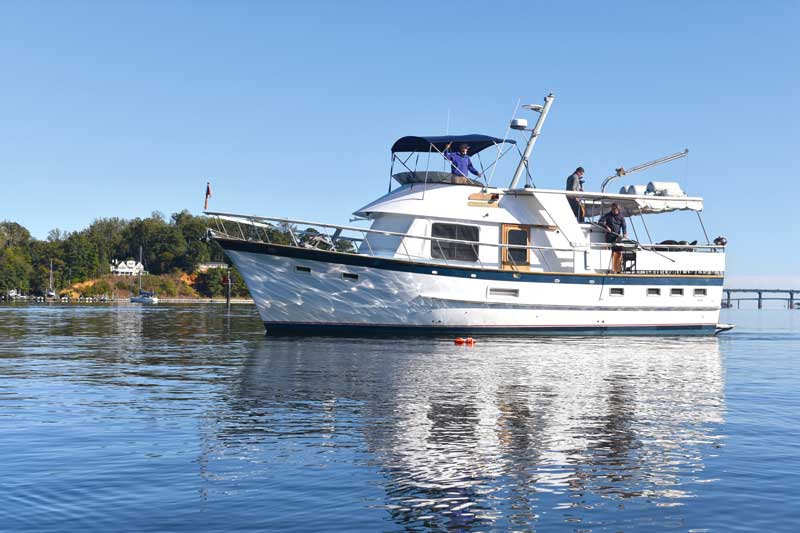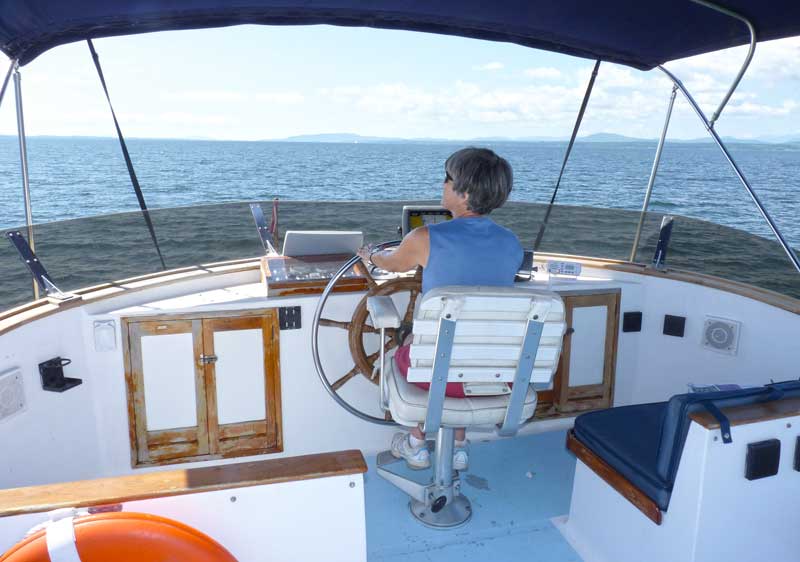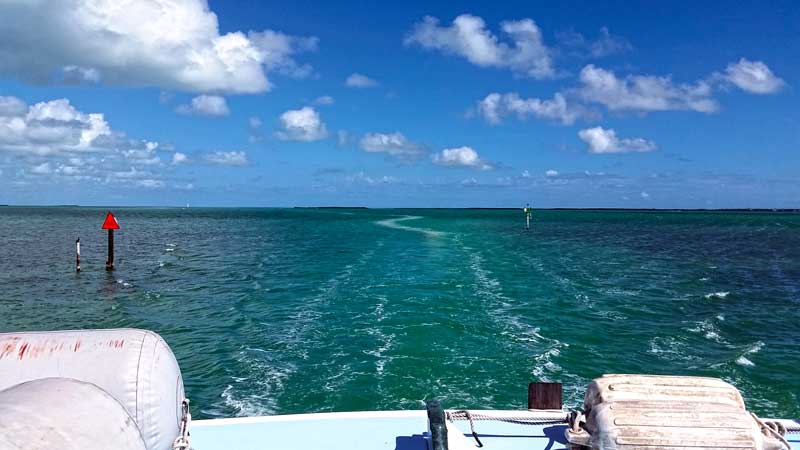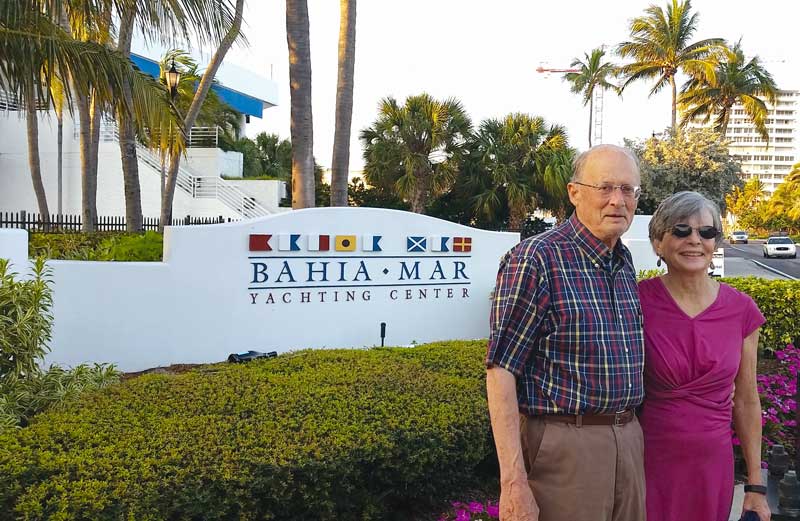You can’t mention selling your boat without several people nodding sagely and tossing out the old aphorism about the two happiest days of boat ownership: the day you buy it and the day you sell it. In the case of Indian Summer that saying isn’t an aphorism at all. An aphorism has to be basically true.

The day we bought Alpha Wave and renamed her Indian Summer was one of optimism and planning for the Burnetts and Iliffs, but with enough uncertainty about what we were getting into that it really didn’t qualify as a great day. Linda Burnett had some experience with her family’s sizeable powerboats, but Bob Burnett, Lucy, and I were entering uncharted waters—to borrow one of those nautical metaphors. Defever 44: twin engines, 44-foot length, 42,000 pounds of 1982 boat, and a substantial survey list of stuff to be done on systems we’d never seen before. Not a day of great comfort. So, it wasn’t hard for following days to be a good deal better than that first one.
All boats are projects; there is always something to be fixed or improved and mysteries to be figured out. When we got Indian Summer, she needed a lot of cosmetic work and a bit of mechanical repair. We did most of it in the spring of 2010 without professional help, but plenty of advice, whether solicited or not. We found her easier to handle than we’d feared, although with some quirks that had to be learned, and fortunately only a few embarrassing mishaps. (No need to list those here.)
Over a few years we got Indian Summer cleaned up. Linda and Lucy accomplished wonderful upgrades in the interior, with furniture, mattresses, upholstery, and carpets. We got the brightwork done and scrubbed the teak decks. We installed a fuel-polishing system and melted a couple of credit cards on new electronics. A clumsy and uncomfortable main companionway hatch was replaced with a phone-booth-shaped entranceway. A heavy and massive wooden mast was replaced with a salvaged aluminum sailboat boom, with lights and radar and TV antennas mounted in a way that the mast could be folded down for low bridges. While all of this was going on, we cruised a bit on the Chesapeake, spent some great evenings at anchor, explored undeveloped creeks, and tracked down marinas with nearby restaurants. Trips included Lankford Creek, Rhode River, Oxford, of course, St. Michaels, the Little Choptank, Solomons, St. Mary’s City, and the Coan River on Virginia’s Northern Neck.

As a little girl, Lucy had spent some time at Cape Vincent, where the St. Lawrence leaves Lake Ontario. One original objective for Indian Summer was the Great Loop, a plan which was deleted from our list fairly early on. Cape Vincent, however, remained as an objective, so in 2012 we embarked on our own “little loop.” Crewed in stages by the Burnetts, Iliffs, and friends and family, Indian Summer went up the Chesapeake, through the C&D Canal, down the Delaware Bay, through the Cape May Canal to Cape May Harbor, up the coast to New York, up the Hudson, through the Erie and Oswego Canals to Lake Ontario, then East across the southern part of the lake to Cape Vincent. Lucy found that Cape Vincent hadn’t changed much. She was able to ride her bike out the same road to the lighthouse that had fascinated her as a 10-year-old.
After some tours of the Thousand Islands, the Burnetts took Indian Summer through the Rideau Canal to Ottawa, then to Montreal, then south to Lake Champlain. From Burlington, VT, Lucy and I brought her south on Lake Champlain to a marina built in 1812: a passage most memorable for its spectacular scenery and nearly complete calm.
The Champlain Canal connected back to the Hudson, after which Indian Summer headed down the Hudson, down the coast, and back home to the Severn. The numbers of great days on that trip are hard to count. One unexpected rough night between Sandy Hook and Cape May was a downer, but led to great “There-we-were...” narratives. Indian Summer handled the trip with aplomb, except at 2 a.m. in the Cape May Coast Guard anchorage when I backed her over a dockline that had trailed overboard. It wound up stopping the starboard engine. The next morning, armed with my trusty sailing knife, I climbed in my skivvies to the swim platform, on the way to cut out the wound-up line and free the prop. A quick look at the knot or so of current going out the cut to the ocean led to selection of plan B. In my dry skivvies, I climbed back on deck and on the port engine got Indian Summer home from Cape May without incident or complaint. I endured insults to my lack of courage without thinking of any effective retorts.

After the little loop, and another trip north to Newport and Martha’s Vineyard, along with our buddy Captain Mike Dais, we got to know the ICW—the Ditch. Indian Summer did several trips up and down, in segments, as far as Key Largo on one trip and the west coast Everglades on another. Again a lot of great days: Favorites include the discovery of Aunny’s Country Kitchen in Georgetown, SC; quiet days touring New Bern, NC, from a new-found favorite marina, and a day and night spent at Bahia Mar in Ft. Lauderdale, FL. Travis McGee’s Busted Flush wasn’t there, but a couple of 300-footers were, along with a gaggle of smaller super-yachts. We figured Indian Summer lent the place some class.
One year, we went across Florida through the Okeechobee to Ft. Myers and visited Sanibel and Gulf Coast barrier islands to its north. One of the best memories of that voyage was a day trip by rental car from a marina in Ft. Myers down to Everglades City to have lunch at the incomparable Rod and Gun Club, which Lucy had visited years ago. Mike Dais was so impressed that he later ran Indian Summer down there with Laura McGuffey and friends and spent a week at the historic resort.

Between trips south, Indian Summer was seen revisiting favorite spots on the Bay, and hitting some new ones: Havre de Grace, Crisfield, Onancock, Hampton—good times all. Whether traveling in waterways we hadn’t seen before, or anchored in the Severn to watch fireworks or the Blue Angels, Indian Summer was fun. We didn’t cruise on Indian Summer for excitement. The best days were quiet and pleasant, but never boring. On days when we waited out bad weather, at anchor or in a slip, Indian Summer was always comfortable, with reading material handy, and the internet available. We watched two Super Bowls on the TV in her salon. For nine years, from the Bay to Canada, to the Florida Keys, Indian Summer traveled comfortably, visiting pleasant marinas and quiet anchorages surrounded by greenery. Great days, great scenery, great food, and great time spent with family and friends.
No: the day we sold Indian Summer was a hell of a long way from the happiest.
By Charlie Iliff